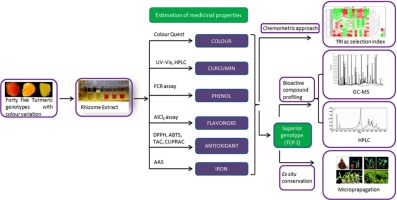Industrial Crops and Products ( IF 5.6 ) Pub Date : 2020-04-13 , DOI: 10.1016/j.indcrop.2020.112401 Kumaresh Pal , Sayan Chowdhury , Sudip Kumar Dutta , Soumendra Chakraborty , Moumita Chakraborty , Goutam Kumar Pandit , Suchand Dutta , Prodyut Kumar Paul , Ashok Choudhury , Biswajit Majumder , Nandita Sahana , Somnath Mandal

|
Turmeric (Curcuma longa L.), the golden spice of India, offers a myriad of health benefits primarily due to the presence of polyphenolic curcuminoid pigments. It is believed that the dark orange colour of turmeric rhizome has wide-spread health benefits; but no reliable evidential proof for this is available till date. It is crucial to discern the association of rhizome colour with health benefits. It is also of prime importance to investigate whether the curcuminoids present in the rhizomes are the sole bioactive compounds contributing to its medicinal properties. In the present study, forty five turmeric genotypes were collected from the sub-Himalayan terai region of India which differed in their rhizome colour. Here, the Turmeric Redness Index (TRI) in terms of rhizome colour content (a*/b*) of the genotypes revealed strong correlation with curcuminoid content (+0.93), total phenol content (+0.76), total flavonoids content (+0.82), iron content (+0.55) and antioxidant activity (–0.90 and –0.92 for DPPH and ABTS assays and +0.82 and +0.95 for TAC and CUPRAC assays, respectively, with p < 0.001). Among the studied genotypes, TCP 2 (Turmeric Collection Pundibari 2) having dark orange coloured rhizome turned out to be a superior genotype in terms of its antioxidant potential, curcuminoid and iron content. Quantification of phenolic and flavonoid compounds of TCP 2 revealed that other than the three isoforms of curcuminoids, different therapeutically important bioactive compounds like p-coumaric acid (162.46 mg/kg), catechin (107.67 mg/kg), sinapic acid (417.36 mg/kg) and flavonoid like quercetin (2746.21 mg/kg) are also present in the rhizome, suggesting that along with curcuminoid these compounds also contribute towards its antioxidant potential. The GC–MS analysis of the essential oil of TCP 2 revealed the presence of thirty three volatile compounds with significantly high ar-turmeron (28.57 %), curlone (10.05 %), eucalyptol (10.13 %) and chemigran (13 %). A rapid and improved micro-propagation protocol was also developed for TCP 2 using single rhizome bud sprout as explants. A media composition of MS with 6 ppm BAP and 2 ppm NAA was found to be the best for rapid and efficient micro shoot development.
中文翻译:

印度喜马拉雅南部地区姜黄基因型(姜黄)的根茎颜色含量,生物活性化合物概况和迁地保护分析
姜黄(姜黄L.)是印度的黄金香料,主要由于存在多酚类姜黄素类色素,因此具有无数的健康益处。姜黄根茎的深橙色被认为具有广泛的健康益处。但到目前为止,尚无可靠的证据证明。辨别根茎颜色与健康益处之间的关系至关重要。研究根茎中的姜黄素类是否是对其医学特性有贡献的唯一生物活性化合物,这也是至关重要的。在本研究中,从印度的喜马拉雅山下亚地区收集了45种姜黄基因型,它们的根茎颜色不同。在此,根据基因型的根茎颜色含量(a * / b *),姜黄红色指数(TRI)显示与姜黄素含量(+0)密切相关。93),总酚含量(+0.76),总类黄酮含量(+0.82),铁含量(+0.55)和抗氧化剂活性(DPPH和ABTS测定为–0.90和–0.92,TAC和CUPRAC测定为+0.82和+0.95 ,分别为p <0.001)。在所研究的基因型中,就其抗氧化能力,姜黄素和铁含量而言,具有深橙色根状茎的TCP 2(姜黄收藏品Pundibari 2)被证明是一种优越的基因型。TCP 2的酚类和类黄酮化合物的定量分析表明,除了姜黄素的三种同工型以外,其他具有重要治疗意义的生物活性化合物如 001)。在所研究的基因型中,就其抗氧化能力,姜黄素和铁含量而言,具有深橙色根状茎的TCP 2(姜黄收藏品Pundibari 2)被证明是一种优越的基因型。TCP 2的酚类和类黄酮化合物的定量分析表明,除了姜黄素的三种同工型以外,其他具有重要治疗意义的生物活性化合物如 001)。在所研究的基因型中,就其抗氧化能力,姜黄素和铁含量而言,具有深橙色根状茎的TCP 2(姜黄收藏品Pundibari 2)被证明是一种优越的基因型。TCP 2的酚类和类黄酮化合物的定量分析表明,除了姜黄素的三种同工型以外,其他具有重要治疗意义的生物活性化合物如对-香豆酸(162.46 mg / kg),儿茶素(107.67 mg / kg),芥子酸(417.36 mg / kg)和类黄酮类槲皮素(2746.21 mg / kg)也存在于根茎中,表明与姜黄素一起存在化合物还有助于提高其抗氧化能力。对TCP 2精油的GC-MS分析显示,存在33种挥发性化合物,其中ar-turmeron(28.57%),curleone(10.05%),桉树油(10.13%)和chemigran(13%)显着较高。还使用单根茎芽萌芽作为外植体为TCP 2开发了一种快速且经过改进的微繁殖方案。发现具有6 ppm BAP和2 ppm NAA的MS培养基组成是快速有效地进行微芽发育的最佳方法。
















































 京公网安备 11010802027423号
京公网安备 11010802027423号